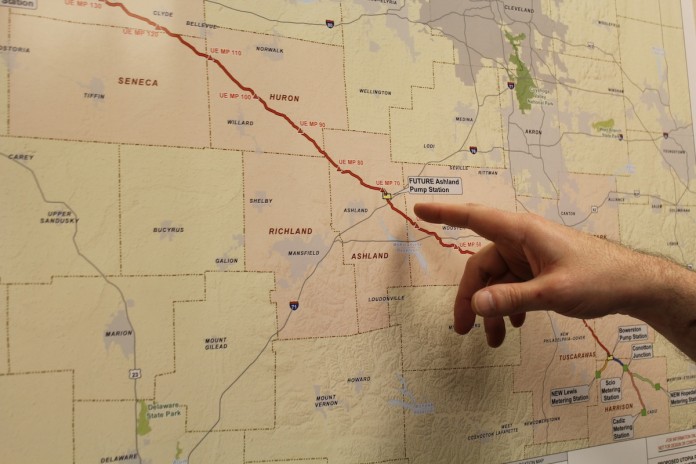ASHLAND, Ohio — Multiple pipeline projects are in the planning stages in Ohio, and one of those is Kinder Morgan’s “Utopia East,” a 240-mile pipeline that would affect about 950 landowners. This intrastate line would transport ethane and ethane-propane mixtures from Harrison County (southeastern Ohio), to Fulton County (northwestern Ohio), where it would connect with the company’s existing lines, and continue into Canada.
Farm and Dairy met recently with Allen Fore, Kinder Morgan’s vice president of public affairs, for a project update.
1. Where does the Utopia East pipeline stand?
Fore: Kinder Morgan has been working on the project for the last year or so. Work continues with various stakeholder groups, including landowners, and the company has met with regulatory agencies.
“We’re looking at beginning the formal permitting process in the next couple of months and anticipating regulatory review of our permits this year.”
Pending regulatory approvals, the company hopes to have construction activity late this year and into next year, leading to an in-service line by first quarter of 2018.
The major regulatory agencies are Ohio Department of Natural Resources, Ohio EPA, Army Corps of Engineers, U.S. Fish and Wildlife Service. (The project does not need Federal Energy Regulatory Commission approval, because it does not cross state lines, and it does not transport natural gas.)
- • •
2. What are you doing to work with landowners?
Fore: Five public meetings have been held, and each of the 950 landowners affected by the line has been contacted. About 200 of the land easements have been acquired.
The company employs environmental and conservation experts to review each property and the type of impact and restoration required.
The company has worked with the Ohio Department of Natural Resources and Ohio Farm Bureau Federation to develop an “Agricultural Impact Mitigation Agreement,” which defines the land features found on farmers’ land, and the proper restoration.
“This lays out all the various areas of responsibility that we have with restoring property. … How we can make sure that the area is restored to avoid any short- or long-term impacts to crops. … Our basic responsibility is to restore the land to as good or better conditions than we found it, as much as is practicable. … If it’s ag land, that’s very doable.”
- • •
3. Is this the final route?
Fore: “It can still be adjusted, but as you get closer to that construction activity, it becomes more difficult to make adjustments, because you (already) surveyed. … If you change that, you’re potentially going into areas that haven’t been surveyed, or you potentially add on additional landowners.”
When the route is moved, it may relieve some landowners, but affect someone else.
- • •
4. What if someone holds out, what can be done?
Fore: “Our record in Ohio is over 99 percent agreeable resolution to our requests for easement, without any long-term issues. ”
If an agreement cannot be made, the company can petition the courts, and assert its status as a common carrier pipeline.
“It’s rarely used and we don’t prefer that method, because when you establish a relationship with a landowner, it’s over the long-term. The pipeline is constructed and then it’s there … we have operations for many, many years at these pipelines, so we want to be sure that those relationships are good and lasting, and for the vast majority of the time they are.”
- • •
5. The plan today is for an ethane and ethane-propane mix line, but could the line be used to transport something different in the future?
Fore: “If we had any changes in that, there would be additional requirements/authorizations necessary for that. But it’s not out of the question that pipelines can be repurposed.”
Other pipelines have been repurposed in the past, based on demand and future circumstances. Kinder Morgan does not own the material being transported — just the pipeline — and bases its decisions on the interest of shippers and suppliers.
- • •
6. There are several other companies planning gas-related lines across Ohio. How do you interact with those and do you face similar challenges?
Fore: “Every company has to build its own projects, and they’re all subject to their own regulatory and permitting approvals. We know the folks, and they’re peers in the industry, but everyone has to do their own project and operate under the same regulatory scheme, but the companies aren’t all the same.”
“One thing is the same across the board — you need to be transparent, you need to be attentive, you need to be responsive. And if you’re not, that’s going to put your project in a backseat position from the outset.”
- • •
7. What kind of job creation and economic impact do you foresee?
Fore: The project is expected to generate about 1,000 temporary union construction jobs, and about five full-time permanent positions.
There will also be economic growth related to consumer spending, and potential growth in the ethane market — which is used for plastics. Plastics companies along the route can potentially tap into the system, to use its resources.
“We’re a common carrier line, so if you want to reserve space on it, there’s an opportunity to do it. ”
Related:
- Learn more about Utopia East, including common questions and answers.
- Interstate pipelines planned in Ohio. (Oct. 23, 2014)










